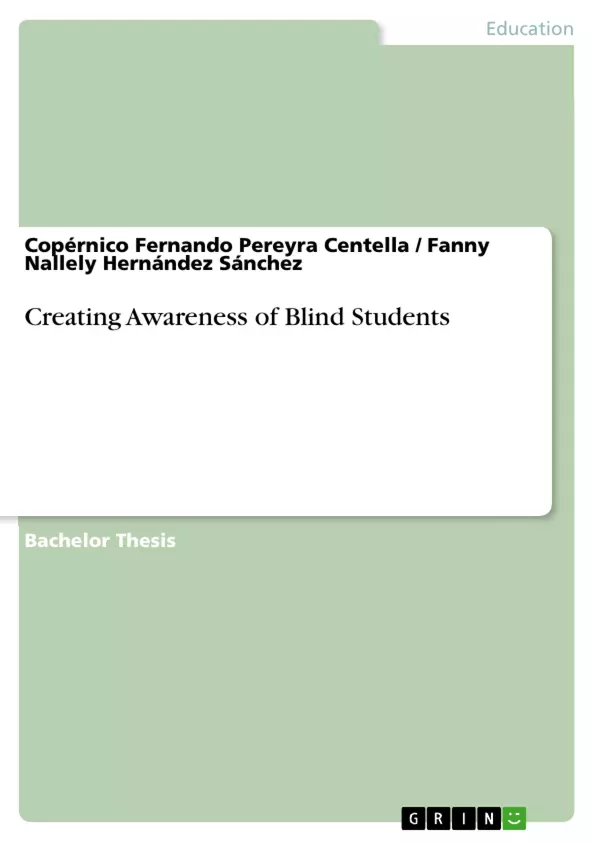When people are learning a second language, they have to make use of all their senses. However, for people with any disability, the situation is different. For this investigation, the issue of creating awareness of blind students in the B.A in English of the language school of the University of Veracruz was searched. We used a mixed monograph, namely, research monograph and monograph of experience analysis. The method that was applied in this paper was the qualitative paradigm and we used the interview and the observation to know what was happening with a blind student in relation to her learning process.
Inhaltsverzeichnis (Table of Contents)
- Introduction
- Chapter I
- Teaching English around the world
- Teaching English to Blind People
- What the Mexican Government is doing to incorporate handicap students to the National Educational System
- What is blindness?
- Differences between a person who was born blind and a person who became blind in any phase of their life
- Associations that help blind people
- Materials and equipment used by the blind
- The Braille system: The most used by the blind
- Chapter II
- Methodology
- Method
- Participants
- Data collection methods
- Procedure
- Chapter III
- Findings
- Origin of Marj's blindness
- Difficulties that Marj has had to face up as a result of her blindness
- Tools that Marj uses to work inside and outside the classroom
- Marj's family support
- Marj's teachers' support
- Marj's partners support
- Marj's achievements
- Associations that had helped Marj
- Strategies that Marj uses to improve her learning
- Important aspects about the Braille system mentioned by Marj
- Experiences from Marj´s partners who have helped her
- Marj´s life Project
- More aspects about Marj
- Chapter IV
- Personal Reflection
- References
Zielsetzung und Themenschwerpunkte (Objectives and Key Themes)
This research focuses on raising awareness about blind students within the B.A. in English program at the Language School of the University of Veracruz. The authors aim to highlight the unique challenges faced by a blind student, Marj, and explore how the university can better support her and future blind students. The study also delves into the lack of awareness and preparedness within the faculty to accommodate students with disabilities, particularly blindness. The authors aim to emphasize the need for inclusive education practices and accessible resources for all students, regardless of their abilities.
- The challenges and adaptations required for blind students in higher education, specifically in the field of English language learning
- The need for inclusive and accessible learning environments within the University of Veracruz
- The importance of awareness and understanding regarding the needs and capabilities of blind students
- The role of teachers and peers in supporting blind students' learning experiences
- The impact of the lack of specialized resources and trained personnel for blind students in the university environment
Zusammenfassung der Kapitel (Chapter Summaries)
- Introduction: This chapter sets the stage for the research by discussing the unique challenges faced by blind students in learning a second language, particularly within the context of the B.A. in English program at the University of Veracruz. The authors introduce the research subject, Marj, a blind student in the program, and highlight the lack of awareness and preparedness to accommodate her needs. They emphasize the importance of creating awareness about the needs of blind students and fostering inclusivity within the university environment.
- Chapter I: This chapter provides background information on teaching English to blind individuals, including the challenges they face, resources available, and the role of the Mexican government in supporting inclusive education for students with disabilities. It also explores the specific challenges and experiences of Marj, focusing on her journey as a blind student and the various aspects of her learning process.
- Chapter II: This chapter outlines the methodology employed in the research, including the specific methods used to collect data, the participants involved in the study, and the procedures followed to gather information. It provides a detailed explanation of the research design and the steps taken to ensure the validity and reliability of the findings.
- Chapter III: This chapter presents the findings of the research, focusing on the specific challenges, supports, and strategies experienced by Marj as a blind student. It analyzes the data collected from Marj, her teachers, and her peers, highlighting the crucial role of family, teachers, and friends in supporting her academic journey. This chapter also explores the impact of Marj's experience on the university environment and raises questions about the need for increased awareness and inclusivity.
- Chapter IV: This chapter provides a personal reflection by the authors, summarizing their experiences conducting the research and the insights gained from their interaction with Marj and the other participants. It highlights the importance of empathy and understanding in fostering a welcoming and inclusive learning environment for all students, regardless of their abilities.
Schlüsselwörter (Keywords)
This study focuses on key topics such as inclusive education, accessible learning environments, and the challenges faced by blind students in higher education. It explores the importance of awareness, understanding, and support for individuals with disabilities. The research analyzes the experiences of a blind student within the B.A. in English program at the University of Veracruz, highlighting the need for appropriate resources and trained personnel to accommodate the needs of diverse learners.
- Citation du texte
- Copérnico Fernando Pereyra Centella (Auteur), Fanny Nallely Hernández Sánchez (Auteur), 2017, Creating Awareness of Blind Students, Munich, GRIN Verlag, https://www.grin.com/document/417885



